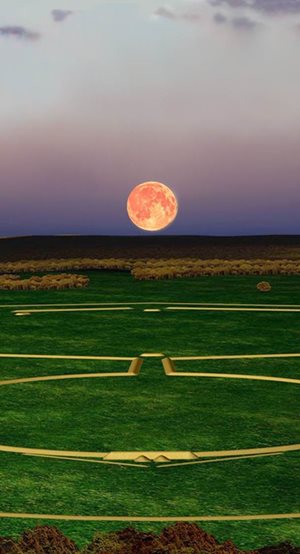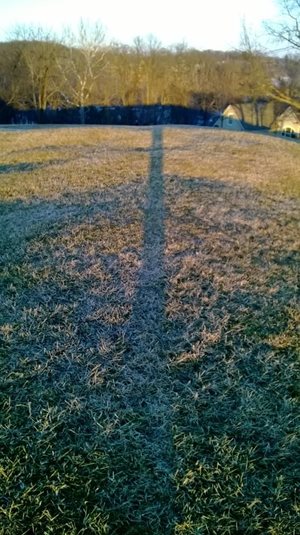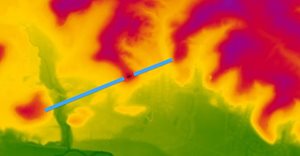Pareidolia is the bane of archaeoastronomy and earthworks.
Pareidolia is the natural human tendency to want to see patterns. Whether it’s a constellation in the night sky, or the face of Jesus in your morning pancake, we are seeking out patterns whether we intend to or not. It appears to be wired into our perceptions, and when you think about trying to spot the leopard in the bush before it spots you, or wanting to notice the nuts hung from a high branch before the hominid next to you, it makes sense that we might be tuned to a hair-trigger.

Which means we can see patterns that aren’t there. Mother Teresa in a muffin and all that. As for archaeoastronomy, the discovery of the alignments at the Octagon of the Newark Earthworks began in 1982 with Ray Hively and Robert Horn questioning Gerald Hawkins’ 1965 claim that there were astronomical significances to key elements of Stonehenge. Our friends from Earlham College pointed out that of some 360 degrees in a full horizon, a little geometry can go a long way.
Between three rise points and three set points for the sun’s cycle (remember that the equinox is one spot crossed twice), four cardinal directions, and throw in a few major night sky markers like the Milky Way’s horizon ends or the rise of Sirius, and their point was a few lines, a couple of gateways, line up this mound and that mound, and you’re bound to run into something significant happening at almost any one spot.
When they ran the calculations for solar alignments at Newark’s Octagon and didn’t find one, they conceded Hawkins might be on to something, but it made them ask “so this may be aimed at something if it’s so emphatically not aimed at the sun’s cycle, but what?” This is where many of us started learning about the moon’s uniquely variable and more complex cycle, which for the sake of this blog post we’ll just boil down to four moonrise points in the east, and four set points to the west.
The fact that the half-mile long symmetry axis of the Octagon assemblage, from Observatory Mound at the back of the circle through the octagonal enclosure, points at the northern extreme rise point of an 18.6 year cycle is clearly significant. It’s very precise, and quite particular. Hively & Horn went on to map and suggest that all eight rise and set points of that cycle (which we’re halfway through, another post for later) are built into this portion of the Newark Earthworks.
But could the completeness of all that be . . . pareidolia? We’re looking for it, and hoping to one degree or another to find it, so we think we can see it. Do we? Peter Dunham and Phil Wanyerka of Cleveland State have pointed out (gently) that we’ve got two very clear alignments, but the others, well . . .
So we test, we debate. It has to be this way, and the consensus develops, sometimes slowly, sometimes too quickly. I don’t push the “every one of the eight lunar cycle rise and set points” view as I once did leading tours.
At Alligator Mound, the idea that the main body of the effigy is aligned to the “Cross-quarter” sunrise & sunset cycle is intriguing (link my previous post), but is it significant? Lacking documentary evidence, is there any support for the idea this is intentional and meaningful, even if we can’t know the precise meaning put to the alignment?
As you stand there, in the case of earlier this week for sunset (the alignment of the mound matches the sunset bracketing winter, and the sunrises bracketing summer), your shadow extends out and out as the sun sets behind Mount Parnassus, and the full length bisects the mound’s core as built – then suddenly your brightly framed shadow vanishes, and the ground becomes entirely dark.
Your shadow, however, does not vanish. It leaps across the valley to the northeast, and is projected by those last rays of the sun onto a facing horizontal hillside.

Okay, it’s not as cool looking as I’d like. Due to the weather and clouds, this was a few days early; the image would be taller and a bit to the right on the actual midpoint between solstice and equinox. The experience, though, is downright visceral. You feel that strange leap of light, and the vision of a black silhouetted giant waving back at you across the valley: it’s truly one of the more amazing things I’ve seen.
Or. . . is it just pareidolia at work? Is it a remarkable coincidence that just happens to look interesting? Thanks to Bob Neinast, another independent scholar who has put quality time into both walking these hills and valleys, and helping deploy LiDAR data as we puzzle over these alignments, he created a map with elevations picked out in color, Alligator Mound in the middle, and I’ve only added the Cross-quarter winter sunsets/summer sunrises axis.
The protruding ridge where Alligator Mound is built at the end is the only place I can find in all of the Licking County region where you would have the “projection screens” at the right locations, enough vertical to the ENE & WSW to have these dancing shadow giants appear for a few moments just before sunset or right after sunrise.
Come May 3, I’ll be up atop this spot, now just before dawn, hoping to get some good film of the “Alligator Hill effect” against the side of Mount Parnassus, the isolated hill to the WSW. Maybe I’ll see you there!

LiDAR image of the Raccoon Creek valley centered on Alligator Mound. The blue line shows the cross-quarter winter sunsets/summer sunrises axis
Jeff Gill